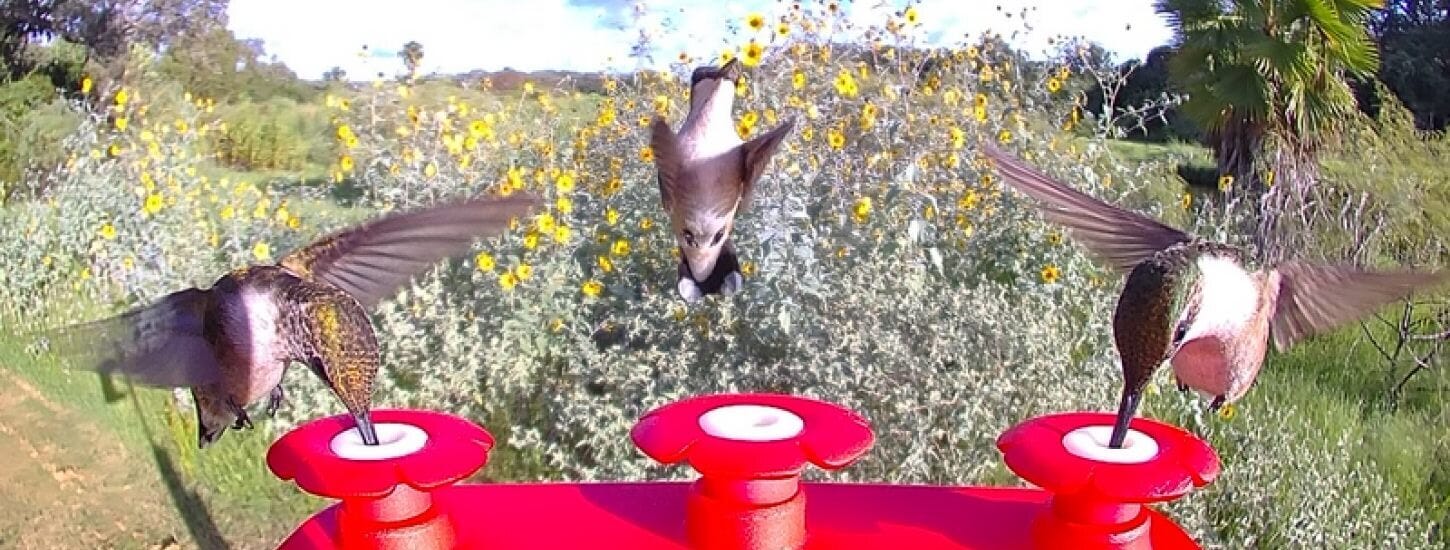

Hummingbirds are known for their vibrant colors and long migrations. They have outstanding memories, the ability to fly backwards and hover, extraordinarily high metabolism, and wings that can flap up to 70 times a second.
But there’s a side to hummingbirds that many people might not be aware of–they can be extremely territorial. They fiercely defend their food sources, and often engage in spectacular aerial displays to keep rivals away. Because of their elusive nature, learning about these traits can be difficult. Let’s look at this behavior in more detail and investigate how a smart hummingbird feeder can help you learn more about these traits.
Why Are Hummingbirds So Territorial?
While hummingbirds may appear delicate, their territorial behavior is a key part of how they survive. Understanding why these little birds fight for their space and food so fiercely requires looking at their unique feeding habits and evolutionary traits.
1. Hummingbirds Have an Energy-Intensive Diet
Hummingbirds’ tiny size and sky-high metabolism means they consume up to half the body weight in food each day. These calories primarily come in the form of sugar-rich flower nectar. Since they need so much, every drop of nectar counts, and they need to secure a reliable, uninterrupted food source. (Fun fact about hummingbirds: They also eat insects!)
2. Hummingbird Metabolism Is High
Hummingbirds’ high metabolism is another reason why they are territorial. To maintain their weight and energy, they need to feed often—sometimes every 10 to 15 minutes. The more birds there are, the less nectar that is available and the quicker resources diminish.
3. Hummingbirds Protect the Resources That Are Important to Them
Hummingbirds’ territorial behavior is based on their need to defend their food sources. They “claim” these sources so they can have access to them whenever they are needed. This territorial instinct is most common when food sources are plentiful.
4. Mating Rituals Can Spur Aggressive Territorial Behavior
Mating can also create territorial behavior. Male hummingbirds will defend a feeding territory to attract females, as this behavior highlights their dominance and ability to provide for themselves and a potential mate. The better a male is at defending a food source, the more attractive he is to a female.
Viewing Hummingbird Territory Battles with a Smart Hummingbird Feeder Camera
While we know that these territorial disputes are taking place, actually seeing them occur is far from easy. Attracting hummingbirds to your feeder can be hard enough—but seeing the actions in detail can be almost impossible. Smart hummingbird feeder cameras provide a fantastic way to witness these fascinating creatures in action, and you never have to leave your home to do so.
1. Live Streaming and Instant Access
Good smart hummingbird feeder cameras have live streaming capability, meaning you can watch territorial skirmishes in real-time from your computer or smartphone. Open the app to see how the birds interact with each other, how they claim and defend their feeders, and how they chase off intruders.
2. Motion Detection and Alerts
Advanced smart hummingbird feeders are equipped with motion sensors that send alerts to your phone when a bird is present. This useful feature means you don’t need to monitor the feeder and that you’re unlikely to miss key moments.
3. High-Quality Imaging
These birds move quickly, meaning your smart bird feeder needs a high-quality lens to ensure you don’t just have blurry images. Look for high-resolution cameras that capture the vibrant colors of the birds' feathers, their rapid movements, and the aerial maneuvers that are part of their defense tactics.
Hummingbirds' territorial behavior is a key part of their survival. While these behaviors are fascinating, they can be hard to observe. A smart hummingbird feeder like the FeatherSnap, which has four nectar feeding ports and a high-resolution camera that sends motion-activated images to an app or web portal, helps to demystify these behaviors and makes them easily viewable by anyone.
